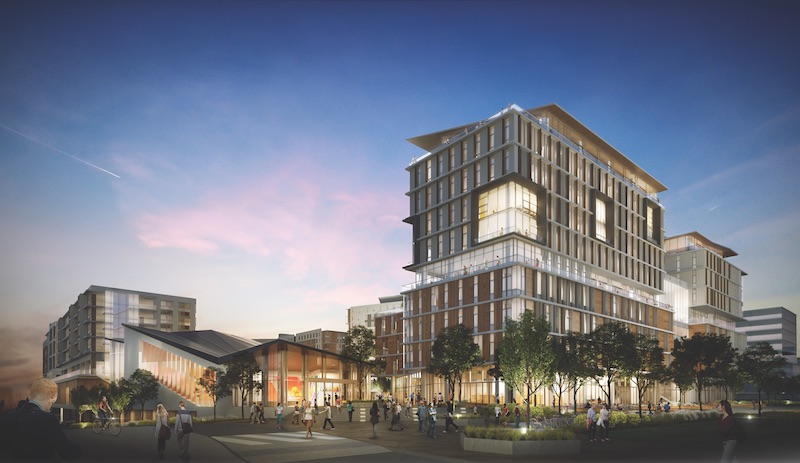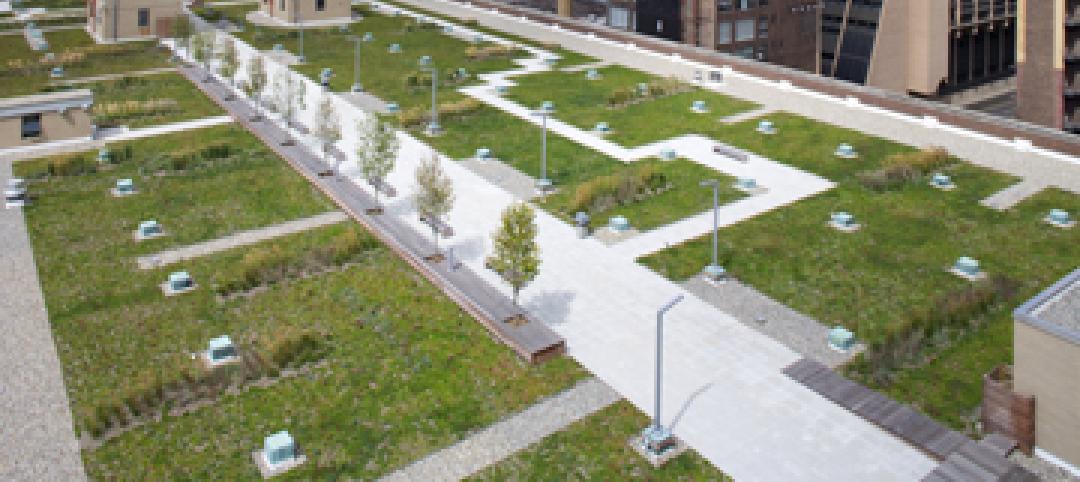Cities and counties around the country are taking sustainability to new heights—and architecture firms are helping them raise the stakes in green design. San Diego and New York are among a growing number of local jurisdictions that are expanding the scope of their energy- and water-use requirements for new construction. The County of San Diego has committed to making all new buildings achieve zero net energy—preferably to produce more energy than they consume through on-site energy generation.
In New York City, staff members at architectural firm FX Collaborative (formerly FXFowle) are actively involved in various task forces related to green building codes and policy. Lately, the focus has been on setting energy use intensity, or EUI, targets for buildings, as opposed to energy cost savings, which is the metric used by LEED and municipal energy codes, says Ilana Judah, AIA, OAQ, LEED AP BD+C, CPHD, FX Collaborative’s Principal and Director of Sustainability. The city recently passed a law that will grade a building’s performance and require the owner to post the grade in a highly
visible location.
Energy-efficiency requirements are getting tougher. Strategies that once were optional are now being incorporated into building and energy codes. Massachusetts now requires multifamily residential buildings in designated Green Communities to comply with higher HERs ratings, Energy Star certification v3.1, or Passive House certification PHIUS+ 2015.
See Also: Top 160 Green Building Architecture + AE Firms
Linda Toth, a Sustainability Specialist in Gensler’s Washington, D.C., office, says a growing number of jurisdictions in every climate zone have green-building mandates coming down the pike for net-zero and net-zero-capable projects. D.C. is currently working on plans to be one of the first municipalities to require net-zero energy for all new residential and commercial construction by 2026, as outlined in the District’s 2016 Clean Energy DC agenda.
Add to that Climate Ready DC, the District’s latest plan to adapt to changing climatic conditions that could produce dangerous heat waves, more severe storms, and drastic flooding that could impact the city’s many historic buildings as well as newer structures. Among the smart-building means to help achieve this goal: high-performing building enclosures, redundant energy and water systems, and correct siting of mechanical systems.
One new form of energy regulation is so-called solar carve-outs, which set specific goals for electricity generated from solar panels. According to the Database of State Incentives for Renewables & Efficiency (DSIRE, at bit.ly/2I5mXxu), 22 states and D.C. have set renewable portfolio standards with solar or distributed-generation provisions. The District of Columbia wants to generate the equivalent of 5% of its buildings’ energy consumption from solar by 2032.
NEW RATINGS SCHEMES SPROUTING UP
In today’s policy climate, “building green” extends well beyond reducing a structure’s carbon footprint. “Energy and water efficiency are great catalysts for larger conversations around sustainability and resilience,” says Benjamin Holsinger, a Sustainability and Wellness Consultant in Gensler’s Washington, D.C., office.
While LEED continues to be the most commonly used framework for green buildings, it’s no longer the only show in town. Design firms are finding that clients are starting to include newer rating systems like SITES, Envision, Fitwel, WELL, and Parksmart in their project requirements.
Last year, The Miller Hull Partnership, a Seattle-based architecture firm, led a so-called Progressive Design-Build team—Arup, KPFF Consulting Engineers, GGN (landscape architect), O’Brien & Company (sustainability consultant), and Mortenson Construction—on the University of Washington’s West Campus Utility Plant. The $35 million facility provides 4,500 tons of chiller capacity and six megawatts of emergency power; it can reach 10,500 tons of chiller capacity and 12 MW of emergency power without modifying the building.
The project achieved Envision Gold Certification from the Institute of Sustainable Infrastructure, the first Envision-certified project at the University of Washington and the first university building in the U.S. to be Envision-certified. Envision is an independent third-party rating system designed specifically to evaluate, grade, and recognize sustainable infrastructure projects.
PASSIVE MEASURES GAINING TRACTION
Clients are pressing their design firms to verify that buildings will perform as promised. To that end, FX Collaborative’s Judah is convinced that passive building practices could be “the future of green building.”
This possibility is already evident on certain academic campuses. In Maine, six of the eight commercial passive house projects that have been built or planned are at private schools. One of these institutions, Bowdoin College, was scheduled to start four residence halls—a total of 47,877 sf of construction—that will comply with Passive House performance requirements. Earlier this year, HKS Architects, in partnership with Clark Construction, broke ground on the University of California, San Diego’s Living and Learning Neighborhood at North Torrey Pines, a seven-building, 1.5-million-sf mixed-use complex. Its passive features range from operable windows for natural ventilation to a modular micro-aerobic digester that will process food waste into biogas and fertilizer for community gardens.
Clients are increasingly engaged with wellness in design, thanks in part to the rollout of LEED v4. They are also expressing greater familiarity with new rating systems, notably the WELL Building Standard, Fitwel, and the Living Building Challenge. They are seeking to go beyond ASHRAE’s minimal ventilation rates and to reduce their use of materials with chemicals of concern.
Gensler has created its proprietary WorkWell methodology. According to Gregory Plavcan, an Associate and Sustainability Specialist, WorkWell gives Gensler’s designers a greater insight on ways to incorporate a client organization’s core values into its wellness regimen.
Related Stories
| Sep 12, 2011
Putting a stamp on USPS's first green roof
The Morgan Building roof totals 150,000-sf. In addition to a vegetated green roof, other roof areas were upgraded and included 55,000-sf of reflective concrete pavers and ballast, which were also placed over a Sarnafil waterproofing membrane, and 40,000-sf of EnergySmart Roof—a reflective, energy-efficient vinyl roofing system from Sika Sarnafil.
| May 18, 2011
Carnegie Hall vaults into the 21st century with a $200 million renovation
Historic Carnegie Hall in New York City is in the midst of a major $200 million renovation that will bring the building up to contemporary standards, increase educational and backstage space, and target LEED Silver.
| May 16, 2011
Seattle unveils program to boost building efficiency
Seattle launched a new program that will help commercial property owners and managers assess and improve building energy efficiency. Under the program, all commercial and multifamily buildings larger than 10,000 sq. ft. will be measured for their energy performance using the EPA’s ENERGY STAR Portfolio Manager.
| May 10, 2011
Are green goals out of reach for federal buildings?
Many federal agencies are struggling to convert their existing buildings to meet green standards, according to the Office of Management and Budget. Of 20 agencies graded by the OMB on their compliance with green mandates, only seven met the 2010 mandate that requires at least 5% of their buildings meet energy-efficient and sustainable standards.
| Apr 14, 2011
U.S. embassies on a mission to green the world's buildings
The U.S. is putting greater emphasis on greening its worldwide portfolio of embassies. The U.S. State Department-affiliated League of Green Embassies already has 70 U.S. embassies undergoing efforts to reduce their environmental impact, and the organization plans to increase that number to more than 100 by the end of the year.
| Feb 7, 2011
GSA Unveils New Sustainable Workplace Design Tool
The U.S. General Services Administration launched its Sustainable Facilities Tool on Monday, Feb. 7. The innovative online tool will make it easier for both government and private-sector property managers and developers to learn about and evaluate strategies to make workplaces more sustainable, helping to build and create jobs in America’s clean energy economy of the future.
| Feb 4, 2011
U.S. Green Building Council applauds President Obama’s Green Building Initiative
The U.S. Green Building Council applauded a key element of President Obama’s plan to “win the future” by making America’s commercial buildings more energy- and resource-efficient over the next decade. The President’s plan, entitled Better Buildings Initiative, catalyzes private-sector investment through a series of incentives to upgrade offices, stores, schools and universities, hospitals and other commercial and municipal buildings.
| Feb 4, 2011
President Obama: 20% improvement in energy efficiency will save $40 billion
President Obama’s Better Buildings Initiative, announced February 3, 2011, aims to achieve a 20% improvement in energy efficiency in commercial buildings by 2020, improvements that will save American businesses $40 billion a year.












